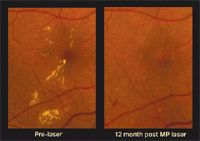Article
Laser therapy: Role in DME?
Author(s):
The use of laser to treat diabetic macular edema is often the topic of debate.

Key Points
Orlando, FL-The use of laser to treat diabetic macular edema (DME) is often the topic of debate. Laser therapy seems to have a place in the treatment of patients with DME, but scarring of the retina should be avoided.

Questions to consider
Considering the first question, Dr. Chong noted that for patients with DME in whom the fovea is not involved, he believes that there is still a key role for laser treatment; in all published studies with anti- vascular endothelial growth factor (VEGF) therapy for DME, this group of patients was excluded. Studies that have been done to date to test the efficacy of anti-VEGF drugs have included patients with foveal involvement of the DME and loss of visual acuity. If the fovea is not involved then the efficacy of the drugs has not been tested and, in Dr. Chong's opinion, the gold standard is still laser treatment.
There is a group of patients for whom laser treatment of DME might be potentially useful. Dr. Chong cited the RESTORE study, a randomized, double-masked, multicenter, laser- controlled phase III European trial of ranibizumab (Lucentis, Genentech) that included 345 patients with visual impairment resulting from DME. The patients were randomly assigned to treatment with 0.5 mg ran i biz u mab and sham laser, 0.5 mg ranibizumab and active laser, or sham injection and active laser. The primary endpoint was the mean average change in best-corrected visual acuity (BCVA) from baseline to month 1 through month 12, Dr. Chong said.

"We can argue that in this particular scenario today in patients with no foveal involvement of DME, there is a substantial role for laser," he said.
"In addition, in patients who have foveal involvement of DME with a mild increase in the retinal thickness, there is a debate about the usefulness of laser," Dr. Chong said. "It might be useful for some, but not for others. This is an area that is worth exploring because it may save the patient from receiving nine to 10 injections of an anti-VEGF drug annually to receive a similar result."
Newsletter
Don’t miss out—get Ophthalmology Times updates on the latest clinical advancements and expert interviews, straight to your inbox.





